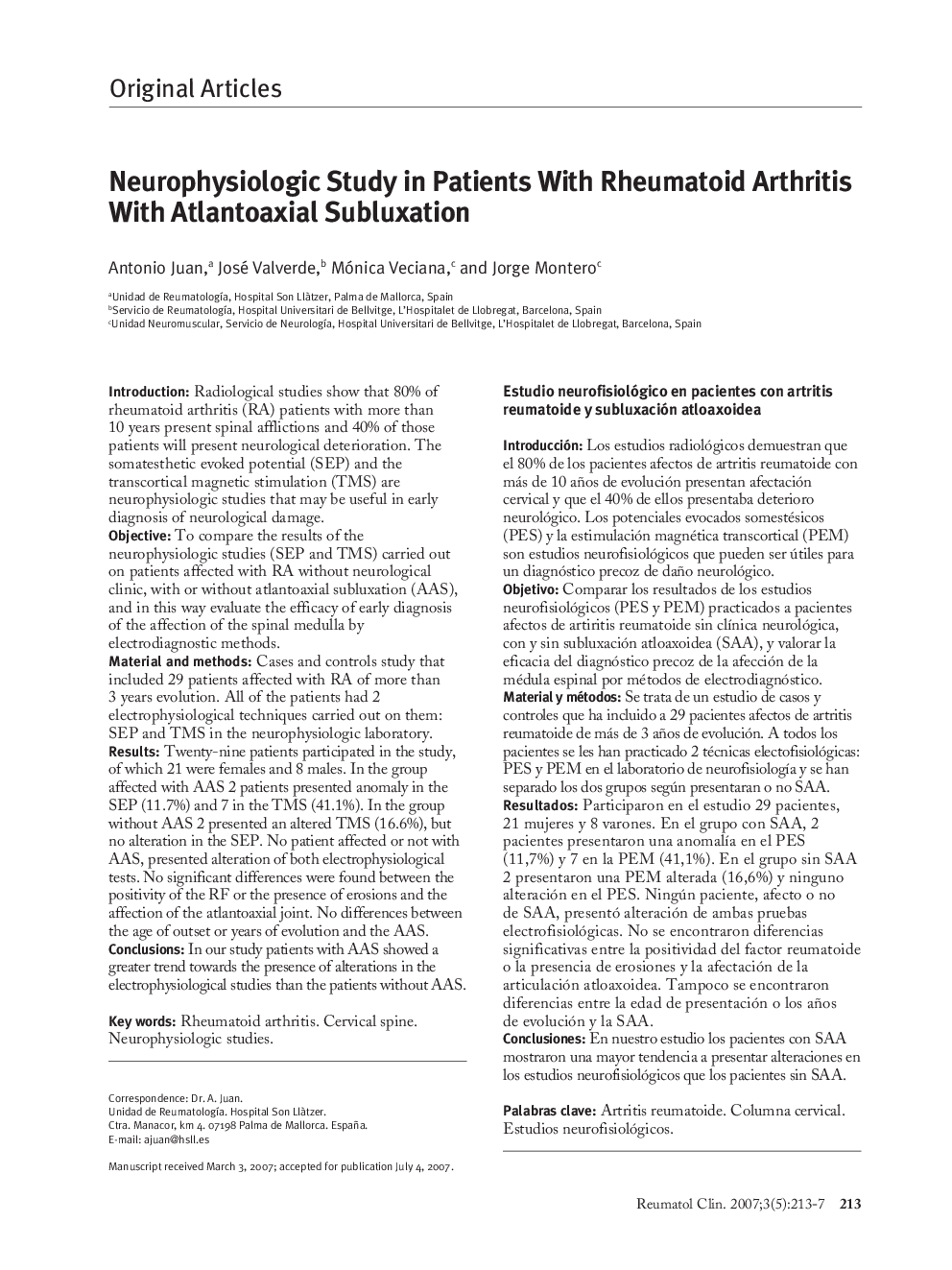| Article ID | Journal | Published Year | Pages | File Type |
|---|---|---|---|---|
| 3384934 | Reumatología Clínica (English Edition) | 2007 | 5 Pages |
IntroductionRadiological studies show that 80% of rheumatoid arthritis (RA) patients with more than 10 years present spinal afflictions and 40% of those patients will present neurological deterioration. The somatesthetic evoked potential (SEP) and the transcortical magnetic stimulation (TMS) are neurophysiologic studies that may be useful in early diagnosis of neurological damage.ObjectiveTo compare the results of the neurophysiologic studies (SEP and TMS) carried out on patients affected with RA without neurological clinic, with or without atlantoaxial subluxation (AAS), and in this way evaluate the efficacy of early diagnosis of the affection of the spinal medulla by electrodiagnostic methods.Material and methodsCases and controls study that included 29 patients affected with RA of more than 3 years evolution. All of the patients had 2 electrophysiological techniques carried out on them: SEP and TMS in the neurophysiologic laboratory.ResultsTwenty-nine patients participated in the study, of which 21 were females and 8 males. In the group affected with AAS 2 patients presented anomaly in the SEP (11.7%) and 7 in the TMS (41.1%). In the group without AAS 2 presented an altered TMS (16.6%), but no alteration in the SEP. No patient affected or not with AAS, presented alteration of both electrophysiological tests. No significant differences were found between the positivity of the RF or the presence of erosions and the affection of the atlantoaxial joint. No differences between the age of outset or years of evolution and the AAS.ConclusionsIn our study patients with AAS showed a greater trend towards the presence of alterations in the electrophysiological studies than the patients without AAS.
IntroducciónLos estudios radiológicos demuestran que el 80% de los pacientes afectos de artritis reumatoide con más de 10 años de evolución presentan afectación cervical y que el 40% de ellos presentaba deterioro neurológico. Los potenciales evocados somestésicos (PES) y la estimulación magnética transcortical (PEM) son estudios neurofisiológicos que pueden ser útiles para un diagnóstico precoz de daño neurológico.ObjetivoComparar los resultados de los estudios neurofisiológicos (PES y PEM) practicados a pacientes afectos de artiritis reumatoide sin clínica neurológica, con y sin subluxación atloaxoidea (SAA), y valorar la eficacia del diagnóstico precoz de la afección de la médula espinal por métodos de electrodiagnóstico.Material y métodosSe trata de un estudio de casos y controles que ha incluido a 29 pacientes afectos de artritis reumatoide de más de 3 años de evolución. A todos los pacientes se les han practicado 2 técnicas electofisiológicas: PES y PEM en el laboratorio de neurofisiología y se han separado los dos grupos según presentaran o no SAA.ResultadosParticiparon en el estudio 29 pacientes, 21 mujeres y 8 varones. En el grupo con SAA, 2 pacientes presentaron una anomalía en el PES (11,7%) y 7 en la PEM (41,1%). En el grupo sin SAA 2 presentaron una PEM alterada (16,6%) y ninguno alteración en el PES. Ningún paciente, afecto o no de SAA, presentó alteración de ambas pruebas electrofisiológicas. No se encontraron diferencias significativas entre la positividad del factor reumatoide o la presencia de erosiones y la afectación de la articulación atloaxoidea. Tampoco se encontraron diferencias entre la edad de presentación o los años de evolución y la SAA.ConclusionesEn nuestro estudio los pacientes con SAA mostraron una mayor tendencia a presentar alteraciones en los estudios neurofisiológicos que los pacientes sin SAA.
